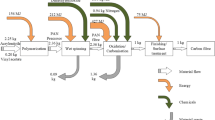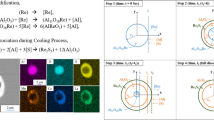Abstract
In this research work, the performance determining criteria’s (PDC) measures like mechanical, tribological and thermo-mechanical etc. of AA2024-SiC alloy composite (i.e. ASC-0; ASC-2; ASC-4; ASC-6) are analysed using hybrid Analytic Hierarchy Process (AHP) and Technique for Order Preferences by Similarity to Ideal Solution (TOPSIS) technique (a Multi-Criteria-Decision-Making (MCDM) technique; computationally simple and easy to understand) in-order-to rank the composites formulations. The order of different PDCs as per AHP is: Coefficient-of-friction > Specific wear rate > Tensile strength ~ Cost > Hardness > Impact strength > Elongation ~ Flexural strength > Voids content ~ Actual density > Fracture toughness > Storage modulus > Thermal conductivity ~ Thermo-gravimetric analysis > Tan δ. The ranking order as per TOPSIS is: ASC-6 > ASC-4 > ASC-2 > ASC-0. The sensitivity analysis study reveals robust ranking-order or priority-order of PDCs as obtained by AHP analysis, when the weights changes from ±30%. The obtained results are in tune with the ranking of the formulations on subjective ground. This proves that MCDM techniques like Hybrid AHP-TOPSIS aids in taking skillful decision by ranking the formulations based on performance measures.
Similar content being viewed by others
References
Ravindran P, Manisekar K, Rathika P, Narayanasamy P (2013) Tribological properties of powder metallurgy - processed aluminium self lubricating hybrid composites with SiC additions. Mater Des 45:561–570. https://doi.org/10.1016/j.matdes.2012.09.015
Kolluri DK, Satapathy BK, Bijwe J, Ghosh AK (2007) Analysis of load and temperature dependence of tribo-performance of graphite filled phenolic composites. Mater Sci Eng A 456:162–169. https://doi.org/10.1016/j.msea.2006.12.027
Çalişkan H, Kurşuncu B, Kurbanoĝlu C, Güven şevki Y (2013) Material selection for the tool holder working under hard milling conditions using different multi criteria decision making methods. Mater Des 45:473–479. https://doi.org/10.1016/j.matdes.2012.09.042
Jahan A, Ismail MY, Sapuan SM, Mustapha F (2010) Material screening and choosing methods - a review. Mater Des 31:696–705. https://doi.org/10.1016/j.matdes.2009.08.013
Ishizaka A, Labib A (2011) Selection of new production facilities with the group analytic hierarchy process ordering method. Expert Syst Appl 38:7317–7325. https://doi.org/10.1016/j.eswa.2010.12.004
Xuebin L (2009) RETRACTED: study of multi-objective optimization and multi-attribute decision-making for economic and environmental power dispatch. Electr Power Syst Res 79:789–795. https://doi.org/10.1016/j.epsr.2008.10.016
Satapathy BK, Bijwe J (2004) Performance of friction materials based on variation in nature of organic fibres part II. Optimisation by balancing and ranking using multiple criteria decision model (MCDM). Wear 257:585–589. https://doi.org/10.1016/j.wear.2004.03.004
Maleque MA, Dyuti S, Rahman MM (2010) Material Selection Method in Design of Automotive Brake Disc. Proc World Congr Eng 2010 III:1–5 2078–0958
Maniya K, Bhatt MG (2010) A selection of material using a novel type decision-making method: preference selection index method. Mater Des 31:1785–1789. https://doi.org/10.1016/j.matdes.2009.11.020
Kiliç Delice E, Güngör Z (2009) The usability analysis with heuristic evaluation and analytic hierarchy process. Int J Ind Ergon 39:934–939. https://doi.org/10.1016/j.ergon.2009.08.005
Zhu Z, Xu L, Chen G, Li Y (2010) Optimization on tribological properties of aramid fibre and CaSO4 whisker reinforced non-metallic friction material with analytic hierarchy process and preference ranking organization method for enrichment evaluations. Mater Des 31:551–555. https://doi.org/10.1016/j.matdes.2009.07.015
Shyur HJ, Shih HS (2006) A hybrid MCDM model for strategic vendor selection. Math Comput Model 44:749–761. https://doi.org/10.1016/j.mcm.2005.04.018
Lin MC, Wang CC, Chen MS, Chang CA (2008) Using AHP and TOPSIS approaches in customer-driven product design process. Comput Ind 59:17–31. https://doi.org/10.1016/j.compind.2007.05.013
Joshi R, Banwet DK, Shankar R (2011) A Delphi-AHP-TOPSIS based benchmarking framework for performance improvement of a cold chain. Expert Syst Appl 38:10170–10182. https://doi.org/10.1016/j.eswa.2011.02.072
Satapathy BK, Majumdar A, Tomar BS (2010) Optimal design of flyash filled composite friction materials using combined analytical hierarchy process and technique for order preference by similarity to ideal solutions approach. Mater Des 31:1937–1944. https://doi.org/10.1016/j.matdes.2009.10.047
Kranthi G, Satapathy A (2010) Evaluation and prediction of wear response of pine wood dust filled epoxy composites using neural computation. Comput Mater Sci 49:609–614. https://doi.org/10.1016/j.commatsci.2010.06.001
Mohanty D, Chandra A, Chakraborti N (2009) Genetic algorithms based multi-objective optimization of an iron making rotary kiln. Comput Mater Sci 45:181–188. https://doi.org/10.1016/j.commatsci.2008.03.056
Mohanty I, Bhattacharjee D, Datta S (2011) Designing cold rolled if steel sheets with optimized tensile properties using ANN and GA. Comput Mater Sci 50:2331–2337. https://doi.org/10.1016/j.commatsci.2011.03.007
Gopal PM, Soorya Prakash K (2018) Minimization of cutting force, temperature and surface roughness through GRA, TOPSIS and Taguchi techniques in end milling of mg hybrid MMC. Measurement 116:178–192. https://doi.org/10.1016/j.measurement.2017.11.011
Akbari M, Shojaeefard MH, Asadi P, Khalkhali A (2017) Hybrid multi-objective optimization of microstructural and mechanical properties of B4C/A356 composites fabricated by FSP using TOPSIS and modified NSGA-II. Trans Nonferrous Met Soc China (English Ed 27:2317–2333 . https://doi.org/10.1016/S1003-6326(17)60258-9
Patel GCM, Shettigar AK, Parappagoudar MB (2018) A systematic approach to model and optimize wear behaviour of castings produced by squeeze casting process. J Manuf Process 32:199–212. https://doi.org/10.1016/j.jmapro.2018.02.004
Singh T, Patnaik A, Gangil B, Chauhan R (2015) Optimization of tribo-performance of brake friction materials: effect of nano filler. Wear 324–325:10–16. https://doi.org/10.1016/j.wear.2014.11.020
Bhaskar S, Kumar M, Patnaik A (2019) Silicon carbide ceramic particulate reinforced AA2024 alloy composite - part I : evaluation of mechanical and sliding tribology performance. Silicon. https://doi.org/10.1007/s12633-019-00181-x
Mardani A, Jusoh A, Nor KMD et al (2015) Multiple criteria decision-making techniques and their applications - a review of the literature from 2000 to 2014. Econ Res Istraz 28:516–571. https://doi.org/10.1080/1331677X.2015.1075139
Yousefpour M, Rahimi A (2014) Characterization and selection of optimal parameters to achieve the best tribological performance of the electrodeposited Cr nanocomposite coating. Mater Des 54:382–389. https://doi.org/10.1016/j.matdes.2013.08.017
Jha K, Kumar R, Verma K, Chaudhary B, Tyagi YK, Singh S (2018) Application of modified TOPSIS technique in deciding optimal combination for bio-degradable composite. Vacuum 157:259–267. https://doi.org/10.1016/j.vacuum.2018.08.063
Yue Z (2011) A method for group decision-making based on determining weights of decision makers using TOPSIS. Appl Math Model 35:1926–1936. https://doi.org/10.1016/j.apm.2010.11.001
Acknowledgements
The authors express their sincere gratitude to Department of Mechanical Engineering of Malaviya National Institute of Technology, Jaipur-302017, Rajasthan, INDIA for their all kind of financial as well as other miscellaneous infrastructural support. The authors also acknowledge the aid and facilities provided by Advanced Research Lab for Tribology and Material Research Centre of the Institute for experimentation and characterization work.
Author information
Authors and Affiliations
Corresponding author
Additional information
Publisher’s Note
Springer Nature remains neutral with regard to jurisdictional claims in published maps and institutional affiliations.
Rights and permissions
About this article
Cite this article
Bhaskar, S., Kumar, M. & Patnaik, A. Application of Hybrid AHP-TOPSIS Technique in Analyzing Material Performance of Silicon Carbide Ceramic Particulate Reinforced AA2024 Alloy Composite. Silicon 12, 1075–1084 (2020). https://doi.org/10.1007/s12633-019-00211-8
Received:
Accepted:
Published:
Issue Date:
DOI: https://doi.org/10.1007/s12633-019-00211-8




